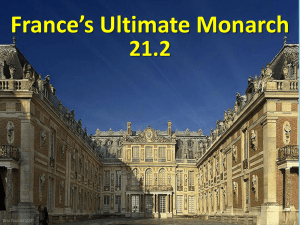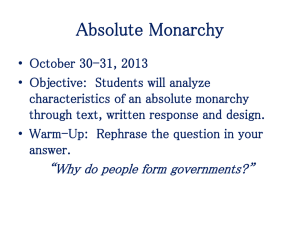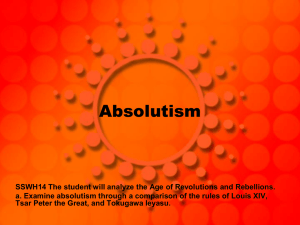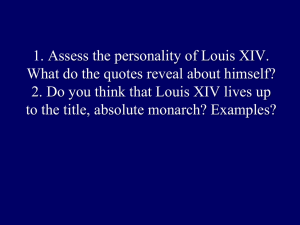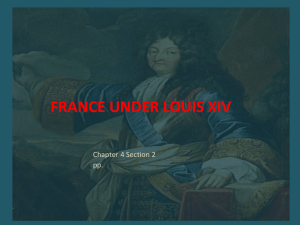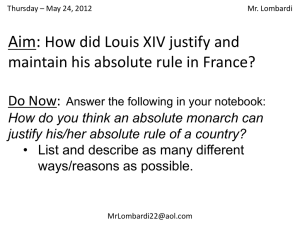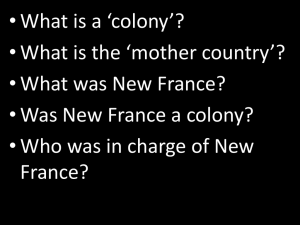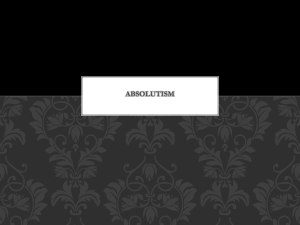Age of Absolutism - France
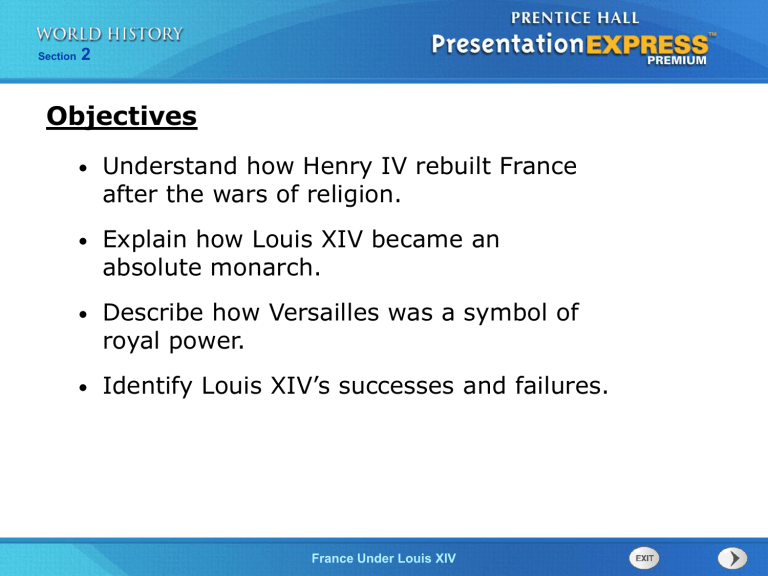
Section
2
Objectives
• Understand how Henry IV rebuilt France after the wars of religion.
• Explain how Louis XIV became an absolute monarch.
• Describe how Versailles was a symbol of royal power.
• Identify Louis XIV’s successes and failures.
France Under Louis XIV
Section
2
Terms and People
• Huguenots – French Protestants of the 1500s and 1600s
• Henry IV – a Huguenot prince who inherited the
French throne in 1589
• Edict of Nantes – a proclamation issued by
Henry IV granting the Huguenots religious toleration and other freedoms
• Cardinal Richelieu – chief minister of France; appointed by Louis XIII in 1624, he devoted 18 years to strengthening the central government
France Under Louis XIV
Section
2
Terms and People
(continued)
• Louis XIV – a king who inherited the French throne in 1643 and went on to rule with absolute power, saying, “I am the state”
• intendant – a royal official who collected taxes, recruited soldiers, and carried out the king’s policies in the provinces
• Jean-Baptiste Colbert – Louis XIV’s finance minister, who imposed mercantilist policies to bolster France’s economy
• Versailles – royal French residence and seat of government established by King Louis XIV
France Under Louis XIV
Section
2
Terms and People
(continued)
• levée – a ritual ceremony performed each morning when King Louis XIV rose from bed
• balance of power – a distribution of military and economic power among nations to prevent any one country from becoming to strong
France Under Louis XIV
Section
2
How did France become the leading power of Europe under the absolute rule of Louis XIV?
France enjoyed a time of peace in the late
1400s in which French kings solidified their power.
Louis XIV became an absolute monarch and built Versailles, a symbol of his power and wealth.
France Under Louis XIV
Section
2
France was torn apart by wars over religion in the late 1500s.
These wars were fought between:
The Catholic majority
French
Protestants,
Huguenots
The worst violence during this time occurred on a Catholic holiday in 1572, when 3000 Huguenots were killed. The incident symbolized a breakdown of order in France.
France Under Louis XIV
Section
2
Henry IV, a Huguenot, inherited the French throne in 1589.
He fought against the Catholics for four years and then converted to Catholicism.
Nevertheless, Henry issued the Edict of Nantes in 1598 to protect the
Protestants by granting the Huguenots religious toleration.
France Under Louis XIV
Section
2
Next, Henry worked to repair France.
His goal was to put “a chicken in every pot.” Henry greatly increased the royal bureaucracy.
Henry IV reduced the power of nobles.
In so doing, he laid the groundwork for future kings to rule without any check on their power.
France Under Louis XIV
Section
2
Henry IV was assassinated in 1610.
His son, Louis XIII, became king.
Louis appointed Cardinal Richelieu in 1624 as chief minister. Richelieu used all of his cunning to strengthen the central government.
He outlawed Huguenot armies and gave the nobles high posts at court to tie them to the king.
France Under Louis XIV
Section
2
Louis XIV became king in 1643 and faced an uprising of nobles, merchants, and peasants.
This effort to take power away from the king was called the
Fronde.
Rioters drove the young king from his palace.
Louis never forgot about this experience.
He decided to take complete control of government and solidify his power as an absolute monarch.
France Under Louis XIV
Section
2
Louis XIV took the sun as the symbol of his total power and declared “I am the state.”
• He never called a meeting of the Estates General, the council made up of representatives of all the social classes, during his reign.
• During this time, Louis appointed middle-class intendants to carry out his policies, and built the
French army into the strongest force in Europe.
France Under Louis XIV
Section
2
All of France’s economic policies were aimed at making the nation the wealthiest state in Europe.
Finance minister Jean-Baptiste Colbert imposed mercantilist policies.
He had new lands cleared for farming.
He put high tariffs on imported goods.
He fostered overseas colonies and carefully regulated trade with these colonies.
France Under Louis XIV
Section
2
Even Colbert’s efforts could not produce enough income to support Louis’s spending.
An example was Louis’s decision to build the immense palace of Versailles.
There, the king insisted on ceremonies such as the levée.
He also let many nobles live at Versailles tax-free to prevent them from threatening his power.
France Under Louis XIV
Section
2
Versailles was designed to be a symbol of royal wealth and power.
France Under Louis XIV
Section
2
Louis XIV ruled France for 72 years.
• His court supported a “splendid century” of the arts in which drama, painting, and ballet flourished.
• Louis sponsored the French Academies, which set standards for the arts and sciences.
At the end of his reign, France was the strongest state in Europe.
France Under Louis XIV
Section
2
Despite these triumphs, Louis made some decisions that led to the decline of France.
He fought costly wars to expand French borders, but was checked by rival rulers hoping to maintain the balance of power.
He tried to unite France and Spain, but was unsuccessful.
He revoked the Edict of Nantes, and 100,000 hardworking and prosperous Huguenots left France.
France Under Louis XIV


